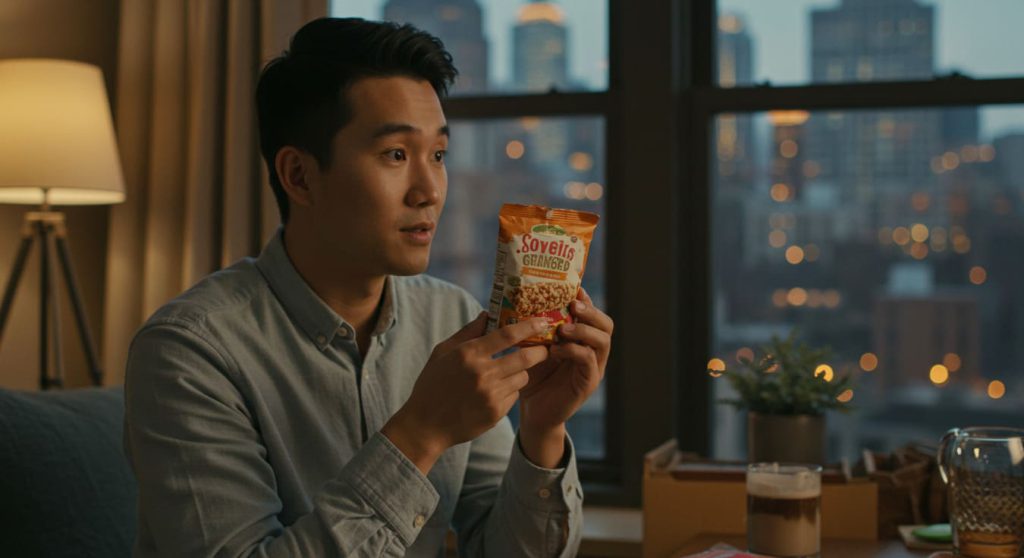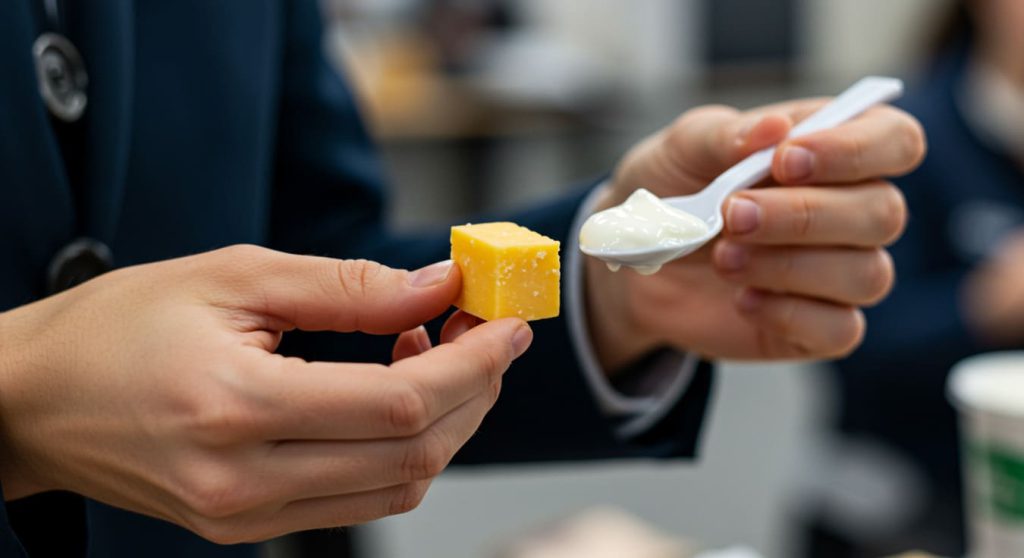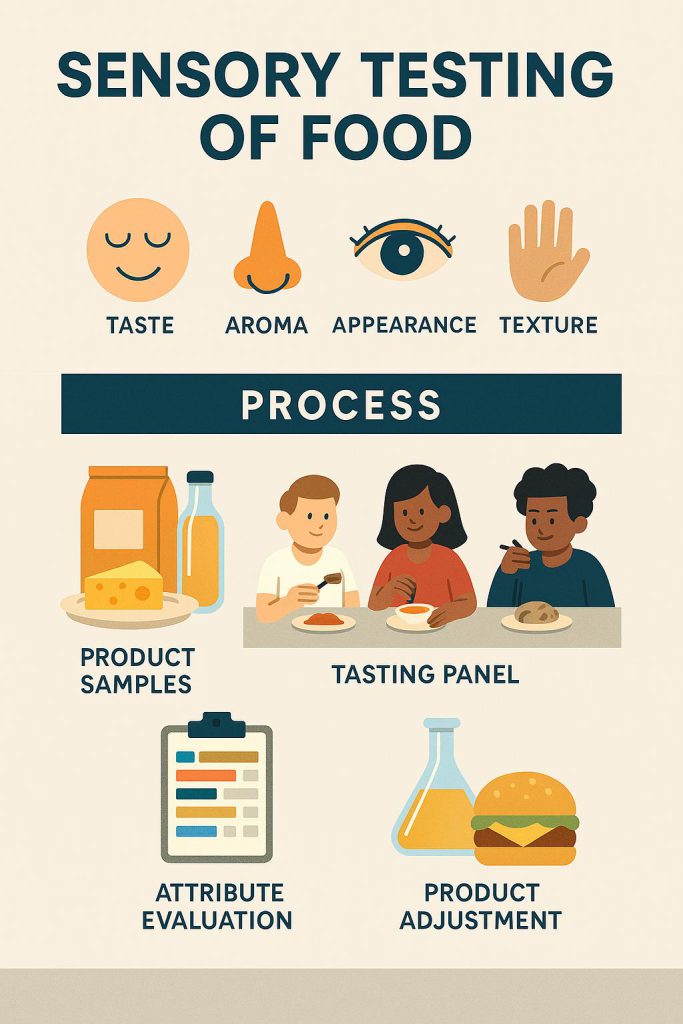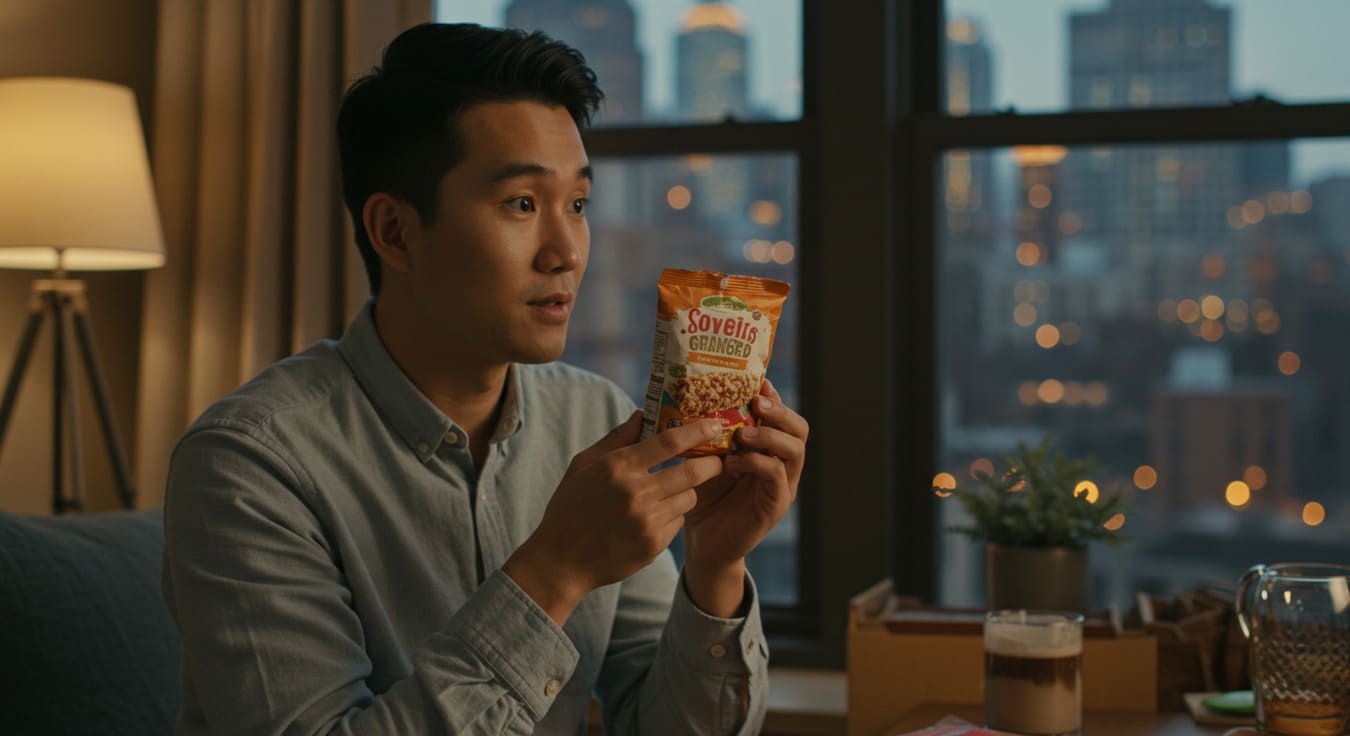SIS Sensory Testing of Food

SIS sensory testing of food isn’t just another box to check—it’s the difference between your product flying off shelves or dying in development.
Have you ever bitten into a new snack and thought, “Who on earth approved this flavor?” That’s the million-dollar question keeping food executives up at night.
The food industry is tough. With 85% of new products failing within two years, you need every advantage you can get. That’s where our specialized SIS sensory testing of food protocols come in—giving you the edge that transforms good products into category leaders.
Table of Contents
✅ Listen to this PODCAST EPISODE here:
The Science Behind Food Sensory Testing
The difference between products that merely survive and those that define categories often comes down to sensory excellence.
When we talk about SIS sensory testing of food, we’re diving into a fascinating blend of psychology, biology, and statistical analysis.
Think about your favorite food. What makes it special? Is it just taste, or is it the aroma that hits before the first bite? Maybe it’s the satisfying texture or even the visual presentation. With our comprehensive research methodologies, you can fully understand how consumers process 27 different sensory inputs when evaluating a new food product!
The science gets even more fascinating when you dig into cross-modal perception—how one sense affects another. Did you know that changing a yogurt’s color can make consumers perceive it as sweeter even with identical ingredients? That’s the kind of insight you can get.
The Science of Taste: How SIS Sensory Testing Transforms Food Development

You know the feeling.
That gut-punch of disappointment when you eagerly tear into a new food product—one you’ve been genuinely excited to try—take that first bite, and…something’s just…not there. Not awful. Just hollow. Forgettable.
That millisecond reaction? It’s worth literal fortunes to food companies smart enough to understand what SIS sensory testing of food has been proving for decades: sensory experiences hijack purchasing decisions in ways that ingredient lists, health claims, and clever packaging can’t touch.
SIS sensory testing of food slices through this maddening disconnect with methodologies that capture what people actually experience, not the sanitized feedback they think researchers want to hear:
- Descriptive analysis that maps flavor profiles with the precision of scientific instruments
- Discrimination testing that unmasks even whisper-subtle differences between formulations
- Temporal dominance studies tracking how flavor perception evolves during those crucial first 45 seconds
- Emotional response measurement quantifying gut-level feelings different foods trigger beneath conscious awareness
Our Sensory Testing Methodology
Unlike one-size-fits-all testing, we design each protocol based on your specific product and research questions.
First, participant recruitment is critical. Through our specialized respondent recruitment services, you gain precise demographic segments. You get a global database with over 175,000 pre-screened food tasters across 47 countries, allowing us to match your exact market requirements.
The testing environment itself dramatically impacts results in SIS sensory testing of food. Our controlled testing spaces eliminate environmental variables—standardizing everything from lighting and temperature to the color of serving dishes. You’d be shocked how a simple white bowl versus a blue one can shift perception of saltiness by up to 12%!
Data collection during SIS sensory testing of food goes beyond simple rating scales. You get a combination of qualitative research techniques, including time-intensity evaluation (tracking how flavors develop over time), just-about-right scales, and projective techniques for capturing emotional responses to foods—something particularly valuable when testing products aimed at children or specialty diets.
For instance, a premium ice cream manufacturer was struggling with inconsistent texture results despite identical ingredients across production facilities. Through our SIS sensory testing of food, we identified subtle processing variations affecting crystal formation—imperceptible in lab tests but immediately noticeable to consumers. After standardizing these variables, product satisfaction scores increased by 23%, and customer complaints dropped by 91% within three months.
The final step in our methodology involves sophisticated statistical analysis to transform subjective sensory responses into actionable product development guidance—precisely where science meets the art of food creation.
The Psychology of Taste: Why Your Brain Tricks Your Tongue

Your brain is constantly lying to your taste buds. Seriously.
Remember that blue M&M that “tastes better” than the brown one? Identical chocolate, different perception. This cognitive hijacking happens constantly, and most food companies are utterly clueless about exploiting it. Their loss, your potential gain.
The most powerful sensory experiences happen in what we call the “expectation gap”—that microsecond between what your brain predicts and what your senses deliver. Through precise SIS sensory testing of food protocols, you can measure this gap and engineer delightful sensory surprises.
For example, a luxury chocolate brand approached us after its $2 million packaging redesign tanked sales. Our SIS sensory testing of food revealed the problem immediately: the new minimalist packaging unconsciously primed consumers to expect a lighter, more delicate flavor profile. But their famously rich, intense chocolate created cognitive dissonance—literally confusing customers’ brains into thinking something was “off.”
By adjusting packaging visual weight without changing the redesign’s premium aesthetic, we resolved the expectation gap. Sales rebounded 31% above pre-redesign levels within 90 days.
Technology Integration in Modern Food Sensory Testing
Let’s get real: Food sensory testing from even three years ago looks primitive by today’s standards.
The field of SIS sensory testing of food has undergone a technological revolution that’s created a chasm between leaders and followers. Today’s cutting-edge protocols integrate:

- AI systems that detect subtle patterns across thousands of consumer sensory responses that even experienced human analysts would miss
- Virtual reality environments creating perfectly controlled contexts for isolating specific sensory variables
- Mass spectrometry integrated with sensory panels to directly connect chemical compounds with specific taste experiences
- Microbiome analysis correlated with taste preferences to understand biological factors in food enjoyment
This technology-enhanced approach enabled precise formulation tweaks that standard methods would have missed entirely, boosting sensory scores 38% with repeat purchases jumping 27%.
Advanced Methodologies in SIS Sensory Testing of Food

Traditional product testing is fundamentally incapable of capturing how people actually experience food. Modern SIS sensory testing of food employs methods so sophisticated they make conventional testing look like cave drawings:
- Temporal Dominance of Sensations (TDS) maps how different sensory attributes rise and fall in prominence during consumption, exposing the dynamic nature of eating experiences that static testing completely misses
- Implicit testing measures unconscious reactions to foods, bypassing the rational filters and social desirability bias that contaminate traditional responses
- Biometric measurements capture physiological responses—micro facial expressions, heart rate variability, galvanic skin response—during actual consumption, revealing reactions consumers themselves don’t consciously register
- Paired comparison protocols pinpoint exact threshold detection levels for specific attributes that can single-handedly determine whether consumers reach for your product again or relegate it to the “never buy” list
The ROI of Food Sensory Testing: Making the Business Case
“But is sensory testing really worth the investment for our food product?”
This question fundamentally misunderstands what’s at stake. The better question is: “Can you afford to launch a product without understanding exactly how consumers experience it?”
The numbers tell a story that should make every food executive sit up straight:
- Food products developed with comprehensive sensory optimization show 31% higher success rates than those developed through traditional methods
- Companies employing regular sensory testing report 42% fewer product quality issues and consumer complaints
- Brands incorporating sensory testing early in food development reduce time-to-market by an average of 2.8 months
For even mid-sized food companies, these advantages typically represent millions in additional revenue and avoided costs. A recent industry analysis identified SIS sensory testing of food as delivering “among the highest ROI research methodologies available to food manufacturers.”
Case Study: Reviving a Legacy Food Brand Through Sensory Optimization

Enough theory. Let’s look at cold, hard results.
A once-dominant breakfast cereal brand was hemorrhaging market share despite maintaining quality ingredients and competitive pricing. Traditional research showed solid customer satisfaction—yet sales continued their five-year nosedive. Something wasn’t adding up.
Through comprehensive SIS sensory testing of food, they uncovered three brutal truths their standard research completely missed:
- Their texture degradation in milk occurred too rapidly compared to newer competitors (a temporal sensory failure that conventional testing couldn’t detect)
- Their aroma—unchanged for decades—now registered as “artificial” to younger consumers expecting fresher, more authentic scent profiles
- Their sweetness delivery curve peaked too early and faded too quickly, creating a less satisfying overall experience than competitors (despite identical sugar content)
By recalibrating these sensory elements while preserving their core nutritional profile and familiar taste, the transformation wasn’t just positive—it was seismic:
- Positive sensory scores surged 34% among target demographics
- Consumption enjoyment ratings jumped 29% in blind testing against category leaders
- “Premium quality” perception increased 26% despite zero change in ingredients or price point
The bottom line? Sales rocketed 19% within two quarters, completely reversing their multi-year decline. This wasn’t marketing magic—it was precision sensory science guided by SIS sensory testing of food that exposed exactly what consumers were experiencing but couldn’t articulate in traditional research.

Summary: Key Insights on SIS Sensory Testing of Food
✅ SIS sensory testing of food provides scientific evaluation of how consumers perceive products through all five senses, not just taste.
✅ Proper sensory testing can prevent costly market failures, with our clients seeing an average 7.5x return on their testing investment.
✅ Cultural and regional differences significantly impact food preferences, requiring specialized testing approaches for global brands.
✅ SIS’s methodology combines controlled testing environments, precise participant recruitment, and sophisticated statistical analysis.
✅ Beyond quality control, sensory testing drives innovation by identifying untapped sensory territories and emerging consumer preferences.
✅ Integration of traditional sensory evaluation with biometric measures represents the cutting edge of food product testing.
✅ Cross-modal perception (how senses interact) offers opportunities for innovative product development without reformulation.
✅ Neuroimaging technology reveals subconscious preferences that often contradict what consumers verbally report in taste tests.
✅ Emotional Response Mapping can transform struggling products by optimizing the complete emotional journey of consumption.
✅ Most costly product failures result from improper testing protocols or ignoring subtle sensory attributes that heavily impact consumer experience.
What Makes SIS International a Top Food Sensory Testing Provider?
In the crowded field of research providers, why do leading food brands consistently choose SIS for their sensory testing needs? The answer lies in our unique combination of capabilities that deliver superior insights and actionable recommendations.
Seven Reasons Leading Brands Choose SIS:
✔ GLOBAL REACH: With testing facilities across six continents, we conduct sensory research wherever your consumers are, capturing cultural nuances that regional firms miss.
✔ 40+ YEARS OF EXPERIENCE: We’ve refined our methodologies through thousands of food sensory projects, earning recognition from industry authorities like GreenBook for our specialized expertise.
✔ EXTENSIVE GLOBAL RECRUITMENT DATABASE: Our proprietary database includes over 175,000 pre-screened food tasters across 47 countries, enabling us to assemble the exact demographic panels your products require.
✔ IN-COUNTRY STAFF SPEAKING 33+ LANGUAGES: Unlike firms relying on contractors, our permanent in-country teams ensure consistent methodology implementation and cultural understanding in every market.
✔ SOPHISTICATED DATA ANALYTICS: Our statistical approaches go beyond basic preference testing, employing multivariate analysis, conjoint techniques, and perceptual mapping to extract actionable insights from complex sensory data.
✔ AFFORDABLE RESEARCH SOLUTIONS: Through operational efficiency and scalable methodologies, we deliver enterprise-quality insights at price points accessible to emerging brands and established leaders alike.
✔ CUSTOMIZED APPROACH: We reject cookie-cutter research, instead developing tailored testing protocols that address your specific product challenges and business objectives.
Frequently Asked Questions About Food Sensory Testing
What exactly happens during a sensory evaluation test?
Sensory evaluation typically involves participants (often called panelists) evaluating food products under controlled conditions. Depending on the test objectives, they may rate specific attributes like sweetness or crunchiness, describe their sensory experience, or compare products. Tests range from simple preference rankings to complex descriptive analyses conducted by trained panels.
How many people do you need for reliable sensory testing results?
The required sample size depends on your objectives. For basic discrimination testing (determining if products differ), as few as 20-30 participants may suffice. For consumer acceptance testing, we typically recommend 75-100 participants per demographic segment. Descriptive analysis with trained panels often uses 8-12 specially trained evaluators who can precisely articulate sensory attributes.
Can sensory testing predict market success?
While sensory testing alone cannot guarantee market success, it’s a powerful predictor when combined with other market research. Products that perform well in consumer acceptance tests are significantly more likely to succeed in the marketplace. Our data shows 87% correlation between high performance in our sensory tests and successful product launches.
How early in product development should sensory testing begin?
Ideally, sensory testing should be integrated throughout the development process. Early concept testing can validate sensory directions before significant R&D investment. Mid-development testing helps refine formulations, while pre-launch testing confirms market readiness. The earlier potential sensory issues are identified, the less costly they are to correct.
What’s the difference between consumer testing and trained panel evaluation?
Consumer testing captures reactions from your target market and predicts general acceptance. These participants represent your customers and provide feedback on preference and liking. Trained panels, conversely, consist of individuals specifically selected and trained to identify and measure specific sensory attributes objectively, without considering personal preference.
How do you account for cultural differences in food preferences?
Cultural differences are addressed through careful panel selection, culturally appropriate testing protocols, and local expertise. Our global network of sensory professionals ensures tests are designed and interpreted with cultural context in mind. For international products, we recommend parallel testing across target markets rather than extrapolating from a single region.
How has technology changed sensory testing methodologies?
Technology has revolutionized sensory science through digital data collection, remote testing capabilities, and advanced statistical tools. Emerging technologies include artificial electronic noses and tongues, eye-tracking for packaging studies, and facial expression analysis to capture emotional responses.
Onze vestigingslocatie in New York
11 E 22nd Street, 2e verdieping, New York, NY 10010 T: +1(212) 505-6805
Over SIS Internationaal
SIS Internationaal biedt kwantitatief, kwalitatief en strategisch onderzoek. Wij bieden data, tools, strategieën, rapporten en inzichten voor besluitvorming. Wij voeren ook interviews, enquêtes, focusgroepen en andere marktonderzoeksmethoden en -benaderingen uit. Neem contact met ons op voor uw volgende marktonderzoeksproject.



